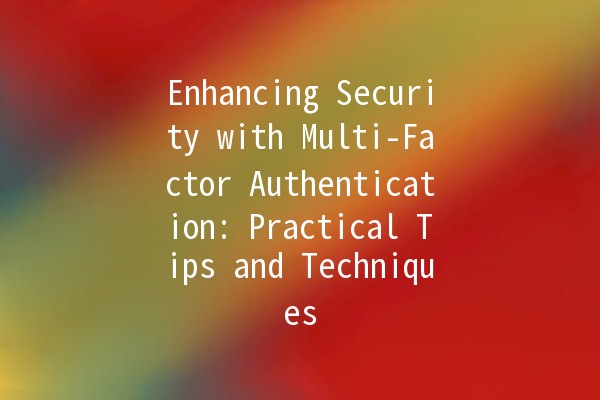
MultiFactor Authentication (MFA) has emerged as a critical security measure for individuals and organizations looking to protect sensitive information from cyber threats. By requiring multiple forms of verification before granting access to accounts, MFA significantly reduces the risk of unauthorized access, making it a vital component of a robust security strategy. This article provides practical tips and techniques for effectively implementing MFA, which can enhance security and user compliance.
What is MultiFactor Authentication?
MultiFactor Authentication is a security system that requires more than one method of verification to gain access to a system or account. Generally, these factors fall into three categories:

Why Use MultiFactor Authentication?
The use of MFA provides several benefits, including:
Increased Security: MFA adds additional layers of security, making it more difficult for hackers to gain unauthorized access.
Reduced Fraud: With hacker tactics becoming more refined, MFA can significantly decrease the success rate of phishing attacks.
Regulatory Compliance: Many industries have regulations requiring strong authentication methods, making MFA a necessary measure.
5 Effective Tips for Implementing MultiFactor Authentication
Explanation
When implementing MFA, it’s crucial to select methods that are appropriate for your organization’s situation and user capabilities. The more diverse the methods, the harder it is for an attacker to bypass MFA.
Practical Application
For example, combining a biometric factor (like fingerprint scans) with a onetime password (OTP) sent to a user’s mobile device creates a strong authentication method. Assess the technological landscape of your user base; if many users are not techsavvy, simpler methods like SMS code may be more effective.
Explanation
User education is key for successful MFA implementation. Users must understand why MFA is necessary and how it functions.
Practical Application
Conduct training sessions or webinars that highlight realworld examples of security breaches that could have been prevented by MFA. Create easytounderstand instructional materials that walk users through the MFA setup process and encourage them to reach out with questions.
Explanation
Cybersecurity threats are constantly evolving, so it’s vital that organizations regularly review and update their MFA methods to defend against new tactics.
Practical Application
Establish a schedule for reviewing your MFA methods every six months. For instance, if currently using SMS as a secondary authentication method, consider upgrading to an authenticator app or hardware token for better security. Remind users to update their methods regularly; for example, rotating their backup email address or phone number can thwart attempts at unauthorized access.
Explanation
Contextual authentication considers the user's behavior and environment when verifying identity. Rather than prompting for MFA every time, it analyzes factors such as location, device, and login behavior.
Practical Application
For instance, if a user normally logs in from a particular location and suddenly attempts to log in from a different country, the system can automatically trigger MFA. This adaptive method enhances security without compromising user experience, creating a seamless login while remaining vigilant against suspicious activity.
Explanation
Regular monitoring of MFA attempts allows for the detection of patterns or unusual behavior that could indicate security threats. Analyzing this data can provide insights into potential vulnerabilities.
Practical Application
Implement a logging system to capture data on authentication attempts—both successful and failed. Automate alerts for suspicious behavior, such as multiple failed login attempts in a short window or logins from unrecognized devices. Use this data to refine your security protocols and adjust your MFA strategies accordingly.
Frequently Asked Questions About MultiFactor Authentication
Yes, MFA is crucial. It adds an additional layer of security, making it significantly harder for unauthorized users to access sensitive information. Given the rise in data breaches and cyberattacks, MFA is a best practice for protecting accounts.
If you lose access to your MFA method, it’s essential to have a backup in place. This could involve recovery codes provided during the MFA setup. Always store backup codes safely. Additionally, consult your organization’s IT support for alternative authentication methods or reset options.
While MFA greatly reduces the chances of unauthorized access, it is not completely foolproof. Attackers may employ tactics such as social engineering or phishing to circumvent it. Therefore, continuous education and updated security measures are essential to maximize effectiveness.
The best MFA method depends on your specific needs and user capability. Generally, a combination of factors, such as biometrics and something you have (like an authenticator app), offers robust security. Evaluate your users' accessibility and comfort with each option to determine what works best.
Most major online services offer MFA options, and it is advisable to implement it wherever possible. This includes email accounts, banking apps, and social media platforms. Ensure to enable MFA on all accounts that contain sensitive data or information.
While some users may view MFA as an inconvenience, educating them about its importance can foster acceptance. Implementing adaptive authentication and minimizing unnecessary prompts can help create a balance between security and user experience.
, implementing MultiFactor Authentication is a vital step toward enhancing security in the digital realm. By choosing the right methods, educating users, and continuously refining strategies, organizations can create a robust security environment that effectively protects sensitive information. The growing prevalence of cyber threats underscores the need for proactive measures like MFA to secure personal and organizational data. Embrace these techniques and safeguard your digital assets effectively!

